



Pig Meat in Australia: Outlook to 2017–18
Australian pig meat production is forecast to fall by two per cent in 2013–14 to around 340,000 tonnes and then to increase gradually over the medium term to around 360,000 tonnes by 2017–18, according to Clay Mifsud and Caitlin Murray in the latest quarterly 'Agricultural Commodities' report from the Australian Bureau of Agricultural and Resource Economics and Sciences (ABARES).A number of factors have affected the Australian pig industry in 2012–13, including
increased feed costs and growing import competition. The weighted average
over-the-hooks price of pigs is forecast to average around 280 cents a kilogram in
2012–13, largely unchanged from the average in the previous year.
During the first
half of 2012–13 the pig-to-wheat and pig-to-barley price ratios averaged 25 per cent
and 22 per cent lower, respectively, leading to a decline in profitability compared
with the same period in 2011–12. During the first half of 2012–13, pig meat imports
increased by 11 per cent, compared with the same period in 2011–12.
In 2013–14 grain prices are forecast to ease but slaughterings are expected to fall
due to a decline in breeding sow numbers. The lower pig meat production is forecast
to lead to the weighted average over-the-hooks price of pigs increasing by four per cent
in 2013–14 to 290 cents a kilogram. However, over the medium term, pig prices are
projected to decline gradually, to 246 cents a kilogram by 2017–18 (in 2012–13
dollars). Downward pressure on pig prices over the medium term reflects a projected
gradual increase in domestic fresh pig meat production, and increased competition
from imports in the processed pig meat market.
With the Australian dollar assumed
to remain relatively strong over the medium term, demand for imported processed
pig meat is projected to rise.
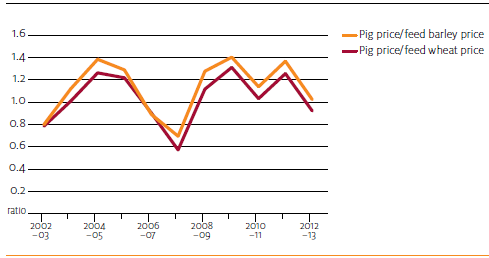
Production to Fall in Short Term, Rise Over Medium Term
Australian pig meat production is forecast to fall by two per cent in 2013–14 to around
340,000 tonnes. This forecast fall in production reflects declining breeding sow
numbers in response to significantly higher grain prices in 2012–13 and increased
competition in the processed meat sector from imports from North America and the
European Union.
The Australian pig herd fell by six per cent over the 12 months to June
2012 to 2.2 million head, the lowest in 40 years.
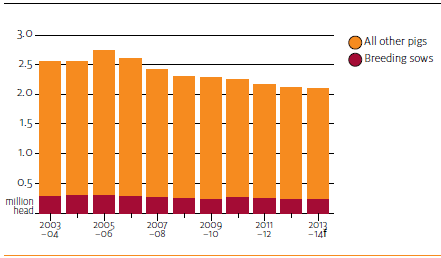
(f = ABARES forecast)
Australian pig meat production is projected to increase gradually over the medium
term to around 360,000 tonnes by 2017–18. Lower projected prices of feed grains,
which account for about 55 per cent of production costs, are expected to support a
partial recovery in pig numbers and pig meat production.
Over the medium term, more domestic production is expected to be directed to the
fresh pig meat market. This is under the assumption that the fresh meat market will
remain closed to imports because of biosecurity restrictions, while the processed
pig meat sector will remain open to competition from imports. Under Australian
biosecurity law, all imported uncooked pig meat must be processed before sale,
usually into bacon, ham or smallgoods.
Australian per person pig meat consumption increased by 20 per cent over the
10 years to 2011–12 to an average of 25kg. Pig meat imports, as a share of
domestic consumption, have grown from 23 per cent in 2002–03 to an estimated
49 per cent in 2012–13.
Over the medium term, average per person consumption of pig
meat is projected to rise to 27kg by 2017–18. A significant proportion of this
projected increase in consumption is expected to be met by imports.
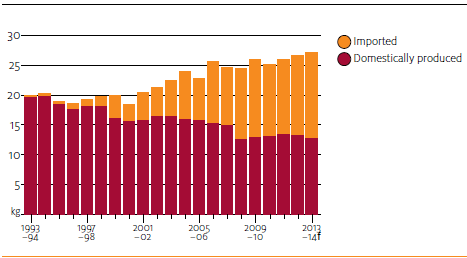
(f = ABARES forecast)
Imports to Rise Over the Medium Term
The pig meat industry is the only Australian meat sector to have been under
competition from significant imports. Over the 10 years to 2011–12, pig meat imports
increased from 47,000 tonnes to 142,000 tonnes.
Australian pig meat imports are forecast to increase by seven per cent in 2012–13
to 152,000 tonnes (shipped weight) and a further nine per cent in 2013–14 to
165,000 tonnes. Higher imports reflect the price competitiveness of Danish
middles and North American legs used in the Australian processed pig meat sector.
Additionally, the assumed high value of the Australian dollar is expected to result
in imports remaining competitive. Over the medium term, pig meat imports are
projected to reach 180,000 tonnes by 2017–18.

(f = ABARES forecast)
Exports to Rise Marginally Toward 2017–18
Australian pig meat exports are forecast to fall by 10 per cent in 2012–13 to
26,000 tonnes (shipped weight), and a further five per cent in 2013–14 to 25,000 tonnes.
Despite an assumed gradual depreciation of the Australian dollar toward 2017–18,
Australian pig meat exports are expected to remain less competitive in many
export markets, particularly against pig meat from the world's three largest pig
meat exporters - Denmark, the United States and Canada.
Over the medium term, Australian pig meat exports are projected to reach about 28,000 tonnes by 2017–18.
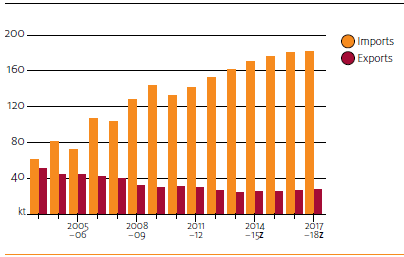
(z = ABARES projection)
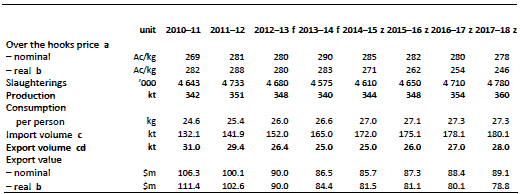
a Dressed weight. b In 2012–13 Australian dollars. c Shipped weight. d Excludes preserved pig meat.
f = ABARES forecast; z = ABARES projection.
Sources: ABARES; Australian Bureau of Statistics
Further ReadingYou can view the full report from ABARES by clicking here.Go to our previous news item on this story by clicking here. |
March 2013








